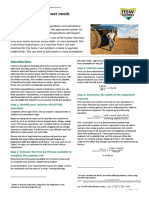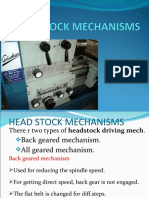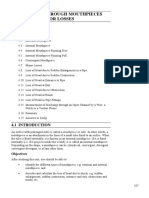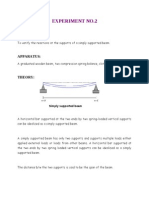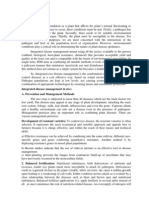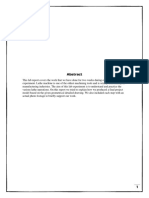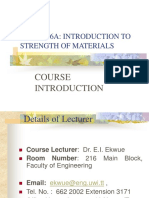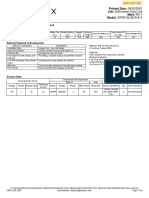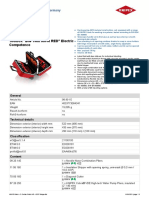Classification of Milling
Uploaded by
Romulus Situ MorankClassification of Milling
Uploaded by
Romulus Situ MorankMilling Machines Milling Milling is a machining process by which a surface is generated by progressive chip removal using a milling cutter
Milling Machine It is a machine tool which removes metal from the work piece as it is fed against the rotating milling cutters. Principle of Milling In milling, the work piece is mounted on the machine table. The table can slide both horizontally and vertically. The milling cutter (s) mounted on the machine spindle. The spindle receives power from a motor and hence the cutter rotates about the axis of the spindle in the vertical plane. Based on the requirement, the table (work piece) is moved against the rotating cutter and the desired machining surface is obtained in a single pass of the work piece. Desired depth of cut may be obtained by multiple passes of the work piece. Equally spaced peripheral teeth over the cutter intermittently engage and machine the work piece. This is called interrupted cutting. It enables the cutter teeth to be cooled effectively till they engage the work piece again. Classification of Milling Basis When the job surface is parallel to the axis of rotation of cutter Peripheral milling Types
When the job surface is at right angles to the Face milling and end milling axis of the cutter When the cutter rotates against the direction of Up milling or conventional milling feed of job When the cutter rotates in the same direction Down milling or climb milling of feed of job. Peripheral Milling shows peripheral milling. Here the axes of cutter and work piece are parallel to each other. Cutter axis. Hence the cutter produces a machined surface parallel to its axis. It is often called 'slabmilling'. The cross section on the resulting surface of the job depends on the rotation of the cutter relative to the direction of feed movement of the work piece, either from left to right or from right to left. Hence there are two types (i) Up milling and (ii) Down milling.
Advantage: Both flat and formed surface can be produced. Disadvantages: (i) Cutting force is not uniform (ii) It results in vibration. Up Milling (Conventional Milling) shows up milling. Here the direction of rotation of cutter and the direction of feed of the work piece are opposite to each other. The cutting force is directed upwards. Hence the cutting increases from zero to maximum per tooth Cutter movement i,e., the thickness of the chip will be minimum at the begining and maximum at the termination of the cutter (i.e., depth of cut = t' mm) Disadvantages: (i) Quality of surface generated will be slightly wavy (ii) Lubrication is difficult. (iii) Needs heavy fixture since the cutting force results in lifting the workpiece. (iv) Results in vibration.
Down Milling (Climb Milling) shows down milling. Here the directions of rotation of cutter will be in the same direction of the feed of the work piece. The cutter tooth starts removing metal at its entry itself Hence the thickness of the chip will be maximum (t, mm) at the begining and minimum at the termination of the cutter. Advantages: (i) Improved surface finish. (ii) Lubrication is easier. (iji) Needs light fixture. (iv) Frictional heat generation is less. Disadvantages: Results in vibration due to backlash error. Hence suitable only for rigid machines provided with back lash eliminator.
Note: Students may tabulate and compare the differences between up milling and down milling, by referring their principles, operations, advantages and disadvantages. Face Milling shows face milling. Here the axes of the cutter and work piece are perpendicular to each other. As the cutter rotates, the work piece may be fed in either directions. Hence both up and down milling may be performed simultaneously. Face milling is a finishing operation after peripheral 'milling, to smoothen the cutter marks of the latter. The thickness of the chip is minimum both at the beginning and at the end of the cut and it is maximum when the work passes through the center line of the cutter. End Milling It is the combination of peripheral and face milling operations. The cutter has teeth both on its periphery and its end. If the direction of helix of the cutter is same as the direction of rotation of it, the end cutting edges are used only to remove metal. If the direction of helix and the direction of rotation of the cutter are opposite to each other, the peripheral cutting edges are used to remove metal.
Classification of Milling Machines Milling machines are classified on the basis of their nature of work i.e., general purpose, special purpose, mass production, reproduction etc., They may be broadly classified as follows: (i) Horizontal (ii) Vertical (iii) Universal (iv) Planer and (v) Special type milling machines. Note : Refer glossary for detailed classification. Plain Horizontal Milling Machine shows a plain horizontal milling machine with its main parts. Its base serves as a foundation member. All the other parts rest upon it, It carries a column at its one end. The column houses all driving mechanisms of spindle and table feed. The spindle receives power mainly from a motor. It supports an overarm at its top, the spindle nose and a knee. The knee is supported on an elevating screw and on the guide ways on the column. It can be moved up and down with the
help of the handle (Part No. 11). The knee supports the working table with the saddle and houses the feed mechanism for them. The table may be moved longitudinally using the handle (Part No. 8). The table is accurately finished with T-slots to clamp the work piece and other fixtures on it. its circular base is graduated in degrees. The saddle mav be ii-loved horizontally using the hand wheel (Part No. 10) which is engaged to a lead screw (not shown in the fig) below the table, An arbor (shaft) is supported between t e spindle nose and the yoke of the over arm and receives power from the spindle. One end of the arbor is tapered so as to fit. in tile spindle nose. The milling cutter(s) mounted on the arbor. It is provided with spacers to facilitate the adjustment for cutter(s) position(s).
Operation The work piece is mounted oil the table with the help of suitable fixtures. The desired contour, feed and depth of cut for the job are noted down. A suitable milling cutter for the specified job is selected and mounted on the arbor. The knee is raised till the cutter just touches the work piece. The machine is started. By moving the table, saddle and the knee, for the specified feed and depth of cut, the desired Job may be finished. The machine may then be switched off.
Operations on Horizontal Milling Machines (i) Plain Milling (Slab Milling): Fig 11.1 shows plain milling. It helps to produce
flat or formed surfaces parallel to cutter axis. A plain or slab milling cutter which has straight or helical teeth is used in the process. There are two types. (i) Up milling and (ii) Down milling. (ii) Slot Milling: It is a process to produce desired slots, grooves
and keyways using different types of cutters. Fig 11.6 (a) illustrates the key way milling operation using a side milling cutter, which has teeth oil its periphery and illqo oil one or both of its sides. Similarly the open slots may also be produced using the plain milling Cutter. Fig. 11.6(b) illustrates closed slot milling using an end mill. T-slots are produced in two steps using a plain milling cutter and T-slot milling cutter as shown in the Fig. 11.6(c). The cutter should be set exactly at the center line of the groove or key way first. Only then the cut should begin. (ii)
Angular milling: It is a process to produce V-blocks and desired angular grooves
with the help of a suitable single or double angle cutter.
(iii)
Form milling: It is a process to produce irregular contours like concave, convex or
any desired shape grooves or edges using a a suitable form cutter.
(iv)
Straddle milling: It is a process to produce square or hexagonal surfaces vertically
on the work piece using two side milling cutters simultaneously. The required distance between the cutters is maintained using suitable collars.
(v)
Gang milling: It is a process of machining several surfaces of a work piece
simultaneously at one pass of it. To do so, a number of desired cutters are mounted on the same arbor. It is useful In repetitive works. It saves machining time to a great extent.
Vertical Milling Machine (Knee and Column Type) Construction shows a column and knee type vertical milling machine with its main parts. Its base serves as a foundation member. All the other parts rest upon it. It is casted with a column at its one end. A spindle head with a swiveling base assembled at the other end of the column. A vertical spindle is housed in the head and connected to the swivel base. The spindle receives power rr-n a motor which is mounted over the spindle head. The cutter is mounted to the spindle. It can be moved up and down using the handle (Part No. 4). A knee is supported on an elevating screw and on the guide ways on the column. It can be moved up and down with the help of the handwheel (Part No. 11). The knee supports the working table with the saddle and houses the feed mechanism. The table may be moved longitudinally using the hand wheel (Part No. 8). The table is accurately finished with T-slots to clamp the work piece and other fixtures on it. Its circular base is graduated in degrees. The saddle may be moved horizontally using the hand wheel (Part No. 10) which is engaged to a lead screw (not shown in figure) below the table. (Note: In a simple vertical milling machine, the saddle and table are mounted over the base without the elevating screw. Hence vertical motion for the saddle and table is not possible.)
Operation The work piece is mounted on the table with the help of suitable fixtures. The desired contour feed and depth of cut for the job are noted down. A suitable milling cutter for the specified job is selected and mounted to the spindle. Both the knee and the cutter are moved vertically opposite to each other suitably, such that the cutter just touches the work piece. The machine is started. By moving the table, saddle swiveling base and the knee for the specified feed, angle, depth of cut etc., the desired job may be finished. The machine may then be switched off. Operations on Vertical Milling Machines (i) (ii) Face milling: Refer Section 11.8, Fig 11.4. End milling: Refer Section 11.9, Fig 11.6(b) and (c).
Comparison of Horizontal and Vertical Milling Machines, Particulars Spindle position. Horizontal Milling Machine Parallel to work table. Vertical Milling Machine Perpendicular to work table.
Spindle movement Motor position Cutter position Cutter movement Cutters used
It rotates only about its axis Housed in the column Supported on the arbor It rotates only about its axis.
It can be swiveled to any desired angle. Mounted head. Mounted spindle. over the spindle to the
-directly
Also possible to move it up and down
Plain milling cutter, Side milling cutter, End milling cutter, Angular million cutter Form milling Slot milling cutter etc., cutter etc., Peripheral milling, Slab milling, Face Face milling, End milling etc., milling Slot milling, Gear cutting etc.,
Operations
You might also like
- Service Manual: Hydraulic Motors Type MS (Y) and MLHS (Y)100% (1)Service Manual: Hydraulic Motors Type MS (Y) and MLHS (Y)9 pages
- COUPP - 60 Hydraulic Hose Failure Analysis100% (1)COUPP - 60 Hydraulic Hose Failure Analysis26 pages
- Efficient Farm Vehicles - Estimating Tractor Power NeedsNo ratings yetEfficient Farm Vehicles - Estimating Tractor Power Needs3 pages
- Unit: 1: Resultant: Parallelogram Law, Triangle Law & Polygon Law of Forces100% (1)Unit: 1: Resultant: Parallelogram Law, Triangle Law & Polygon Law of Forces4 pages
- Government Polytechnic Muzaffarpur: SUBJECT CODE - 1625507100% (1)Government Polytechnic Muzaffarpur: SUBJECT CODE - 162550714 pages
- 5 - Shaping Machine ME 46 Machine Shop Theory and PracticeNo ratings yet5 - Shaping Machine ME 46 Machine Shop Theory and Practice38 pages
- Unit 4 Flow Through Mouthpieces and Minor Losses: StructureNo ratings yetUnit 4 Flow Through Mouthpieces and Minor Losses: Structure25 pages
- 3.two Dimensional Potential Flow Theory - ContunedNo ratings yet3.two Dimensional Potential Flow Theory - Contuned66 pages
- DRAW10W - Intersections and Development of SurfacesNo ratings yetDRAW10W - Intersections and Development of Surfaces8 pages
- Department of Mechanical Engineering Answer Key - Iat-I Subject Name: Manufacturing Technology Year/Sem: II/III Subject Code: 17MECC04 Part-A Answer All The Questions (7x2 14 Marks)No ratings yetDepartment of Mechanical Engineering Answer Key - Iat-I Subject Name: Manufacturing Technology Year/Sem: II/III Subject Code: 17MECC04 Part-A Answer All The Questions (7x2 14 Marks)7 pages
- Band Saw (Missing Shop Manual): The Tool Information You Need at Your FingertipsFrom EverandBand Saw (Missing Shop Manual): The Tool Information You Need at Your FingertipsNo ratings yet
- PWO Water/oil Cooler: Lightweight, Compact and Efficient For Industrial and Marine ApplicationsNo ratings yetPWO Water/oil Cooler: Lightweight, Compact and Efficient For Industrial and Marine Applications12 pages
- PARKER Hydraulic Hose, Fittings, & Equipment Technical Handbook100% (1)PARKER Hydraulic Hose, Fittings, & Equipment Technical Handbook63 pages
- New-Product Development and Product Life-Cycle Strategies: Company Case Notes Samsung: From Gallop To RunNo ratings yetNew-Product Development and Product Life-Cycle Strategies: Company Case Notes Samsung: From Gallop To Run4 pages
- CAD BIM Typicals ASSET DOC LOC 8373945 PDFNo ratings yetCAD BIM Typicals ASSET DOC LOC 8373945 PDF8 pages
- Manual Transaxle: Service Data and Specifications (SDS) Have Been ChangedNo ratings yetManual Transaxle: Service Data and Specifications (SDS) Have Been Changed136 pages
- Learning Module For Epp 5: East Negros Academy, IncNo ratings yetLearning Module For Epp 5: East Negros Academy, Inc16 pages
- Galley Range Hood - 33821007-801 (Rangehood XRRS)No ratings yetGalley Range Hood - 33821007-801 (Rangehood XRRS)6 pages
- Laporan Kondisi Mesin Robot Welding: Manipulator Controller InverterNo ratings yetLaporan Kondisi Mesin Robot Welding: Manipulator Controller Inverter5 pages
- Store and Regional Sales Database ID Store No. Sales Region Item No. Item Description Unit Price Units SoldNo ratings yetStore and Regional Sales Database ID Store No. Sales Region Item No. Item Description Unit Price Units Sold11 pages
- Manual de Usuario e Instalacion Unidad Interior Ab35 Ab50No ratings yetManual de Usuario e Instalacion Unidad Interior Ab35 Ab50157 pages
- B.TECH. (5 Semester) Production and Industrial Engineering Pi-319 Vocational Training ReportNo ratings yetB.TECH. (5 Semester) Production and Industrial Engineering Pi-319 Vocational Training Report10 pages
- Service Manual: Hydraulic Motors Type MS (Y) and MLHS (Y)Service Manual: Hydraulic Motors Type MS (Y) and MLHS (Y)
- Efficient Farm Vehicles - Estimating Tractor Power NeedsEfficient Farm Vehicles - Estimating Tractor Power Needs
- Unit: 1: Resultant: Parallelogram Law, Triangle Law & Polygon Law of ForcesUnit: 1: Resultant: Parallelogram Law, Triangle Law & Polygon Law of Forces
- Government Polytechnic Muzaffarpur: SUBJECT CODE - 1625507Government Polytechnic Muzaffarpur: SUBJECT CODE - 1625507
- 5 - Shaping Machine ME 46 Machine Shop Theory and Practice5 - Shaping Machine ME 46 Machine Shop Theory and Practice
- Unit 4 Flow Through Mouthpieces and Minor Losses: StructureUnit 4 Flow Through Mouthpieces and Minor Losses: Structure
- 3.two Dimensional Potential Flow Theory - Contuned3.two Dimensional Potential Flow Theory - Contuned
- DRAW10W - Intersections and Development of SurfacesDRAW10W - Intersections and Development of Surfaces
- Department of Mechanical Engineering Answer Key - Iat-I Subject Name: Manufacturing Technology Year/Sem: II/III Subject Code: 17MECC04 Part-A Answer All The Questions (7x2 14 Marks)Department of Mechanical Engineering Answer Key - Iat-I Subject Name: Manufacturing Technology Year/Sem: II/III Subject Code: 17MECC04 Part-A Answer All The Questions (7x2 14 Marks)
- Band Saw (Missing Shop Manual): The Tool Information You Need at Your FingertipsFrom EverandBand Saw (Missing Shop Manual): The Tool Information You Need at Your Fingertips
- PWO Water/oil Cooler: Lightweight, Compact and Efficient For Industrial and Marine ApplicationsPWO Water/oil Cooler: Lightweight, Compact and Efficient For Industrial and Marine Applications
- PARKER Hydraulic Hose, Fittings, & Equipment Technical HandbookPARKER Hydraulic Hose, Fittings, & Equipment Technical Handbook
- New-Product Development and Product Life-Cycle Strategies: Company Case Notes Samsung: From Gallop To RunNew-Product Development and Product Life-Cycle Strategies: Company Case Notes Samsung: From Gallop To Run
- Manual Transaxle: Service Data and Specifications (SDS) Have Been ChangedManual Transaxle: Service Data and Specifications (SDS) Have Been Changed
- Learning Module For Epp 5: East Negros Academy, IncLearning Module For Epp 5: East Negros Academy, Inc
- Laporan Kondisi Mesin Robot Welding: Manipulator Controller InverterLaporan Kondisi Mesin Robot Welding: Manipulator Controller Inverter
- Store and Regional Sales Database ID Store No. Sales Region Item No. Item Description Unit Price Units SoldStore and Regional Sales Database ID Store No. Sales Region Item No. Item Description Unit Price Units Sold
- Manual de Usuario e Instalacion Unidad Interior Ab35 Ab50Manual de Usuario e Instalacion Unidad Interior Ab35 Ab50
- B.TECH. (5 Semester) Production and Industrial Engineering Pi-319 Vocational Training ReportB.TECH. (5 Semester) Production and Industrial Engineering Pi-319 Vocational Training Report



